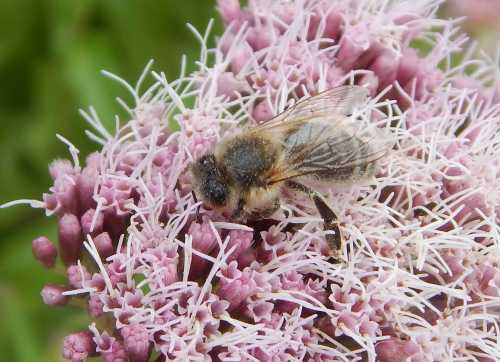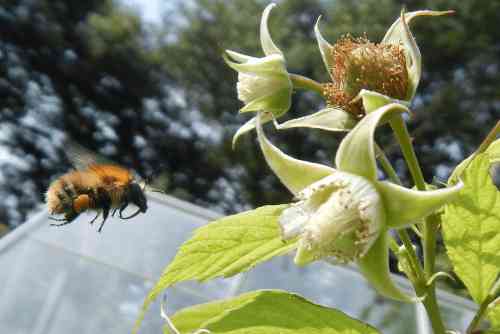How Far Do Bees Fly For Food?
Here, we
explore the questions 'what is the foraging range of bees?' and 'How far do bees fly to forage for nectar and pollen?' as well as 'What environmental factors affect foraging?'.
We’ll also look at how scientists gather the research, and why this question is important.
How Far Do Bees Fly?
There may be multiple factors affecting the recorded distances travelled by bees, such as:
- the methods used to gather data within the experiment, or,
- the different environments and,
- the time of year when the research was conducted.
It is therefore perhaps no surprise that research by various scientists have recorded different results, even for the same species.
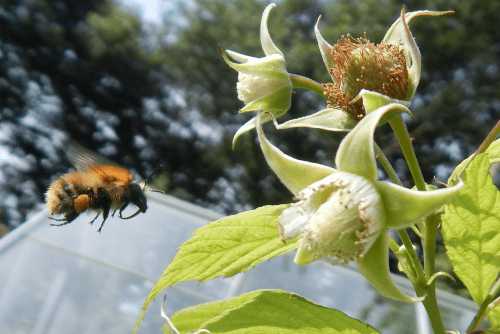
Here is a brief summary of some of the research, but you may certainly come across further data!
Honey Bee Flight Distance
In research, honey bees have been observed to fly anywhere between 1 – 6 km (with a mean of 5.5 km)1 but also up to 13.5 km2. (I have seen it stated that 20 km has also been recorded, but have not located the research paper to check this finding).
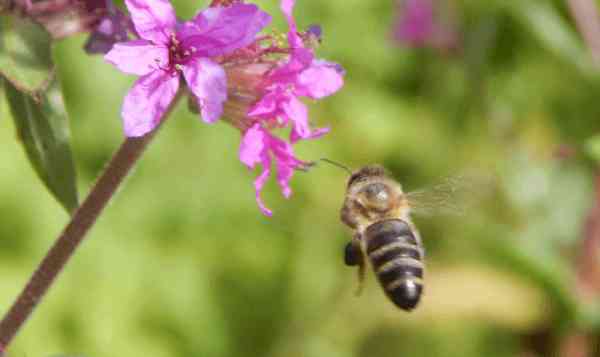
In general, it is believed honey bees are not ‘doorstep’ foragers. However, I query this to some extent.
In part, it may depend on how one defines the term "doorstep". Furthermore, one paper found that foraging distance is affected by seasonal factors.
I have certainly witnessed honey bees foraging on a very cold but sunny January day, and I located the wild honey bee nest in a tree trunk a few yards away.
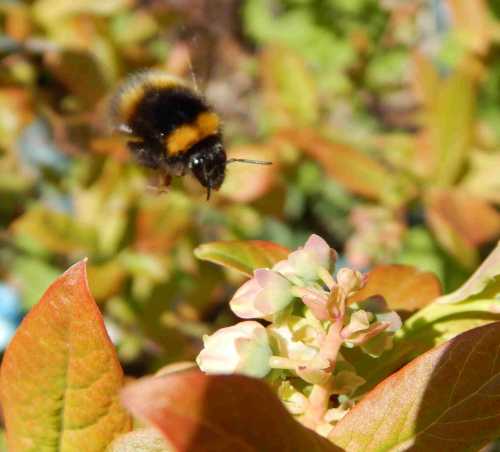
How Far Do Bumble Bees Fly?
Various distances have been recorded in research. The distances have ranged between 100 m and 1.7 km from the nest.
For example, research from Darvill et al (2004)3 found that Bombus pascuorum foraged over distances less than 312 m and Bombus terrestris less than 625 m from their nests.
They proposed that bumble bee species differ greatly in fundamental aspects of their ecology.
Other Bee Species
- It is generally believed that solitary bees do not fly great distances to find food,
although 1 km – 2.4 km has been recorded for some species. However, an exceptional
23 km was recorded for a tropical species, the Euglossine
bee, Euplasia surinamensis (this distance was observed after
devising a ‘homing’ experiment - see research methods below).
Another Euglossine bee, Euplasia surinamensis, was able to return home from a distance of 23 km6.
- Researchers have found that the stingless bee, Melipona fasciata travels up to 2.4 km4. Melipona mandacaia can forage in their native habitat up to 2.1 km, with the larger bees of this species able to forage at greater distances than smaller foragers5.
Maximum flight distances for various medium sized bees of the Meliponini ranged from 1159 m to 1710 m7.
See further research about the foraging range of bees.
Environmental Factors Affecting Foraging Abilities Of Bees
The ability of bees to reach their potential as foragers, may of course be influenced by environmental factors, such as:
1. Abundance of suitable flowers.
2. Air pollution.
3. Whether appropriate habitats are linked (i.e. creating pollinator corridors).
4. Temperature and seasonality factors.
Why Is It Useful To Know How Far Bees Fly?
Farming And Food Production
Being aware of the distances bees fly to reach flowers means that farmers can be advised about the number of colonies or bee boxes to site on their land, in order to improve crop yields.
Conservation Applications
Efforts of conservationists to create
habitat must take into the account the importance of ensuring habitats are connected.
If habitats are fragmented, this can set up future problems, such as inbreeding in bees, which can, for instance, result in male bumble bees being produced in a colony instead of worker females.
Pesticide Regulation
This question has proven to be relevant in EFSA's investigation into neonicotinoids and testing of pesticides.
Honey bees were used during the testing process of neonicotinoid pesticides, but their manufacturers came under criticism for the limited scale of their field tests, that did not replicate realistic foraging conditions.
Organic
Certification
In the case of gaining of certain organic
certifications, the environment of the honey bee’s foraging range has to be
considered to help ensure honey bees will not bring home
contaminated nectar or pollen.
5 Research Methods Used To Discover The Distances Bees Fly For Food
It's not necessarily easy to find an accurate and reliable method to
measure the distances bees will fly to forage for food.
Various methods have been used to gather research data about the foraging ranges of bees, but debate continues.
1. Honey Bees And The Waggle Dance
Scientists have made significant progress since the honey bee dance was decoded by Austrian ethologist, Karl von Frisch in 1967.
The waggle dance describes not only the direction of good foraging locations but also distance.
Knowledge of the waggle dance has sometimes been used by scientists to help them understand how far honey bees fly to gather nectar and pollen.
2. Flight Distance Measurement And Marking Bees
Other studies have used the method of marking bumble bees. Scientists then search the surrounding areas for marked bees, and measure the distance from the nest.
However, this method does have problems.
It can lead to 'observer bias' due to scientists searching only small distances around a nest. To remove such bias, and extend the observations merely to 1 km from a nest, would require a thorough search of 3.1 square km.
Observing bumble bees over such an area would be a tremendous undertaking!
3. Homing Experiments
Because bees have homing abilities, tests have been devised to remove bees from their nests, and set them free at various distances from their homes, to see if they could return.
When Janzen (1971)6 found that the Euglossine bee, Euplasia surinamensis, was able to return home from a distance of 23km. The bee had returned with full pollen baskets, which of course indicates foraging.
However, the question remains about how applicable this is to other bee species and what will happen in natural circumstances when the bees are left to their own devices?
4. Using Harmonic Radar
This method involves attaching an aerial-like transponder to the thorax of the bee.
Information gathered using this method has found that bumble bees can navigate cross-winds, but unfortunately this method can only record distances of up to 700m.
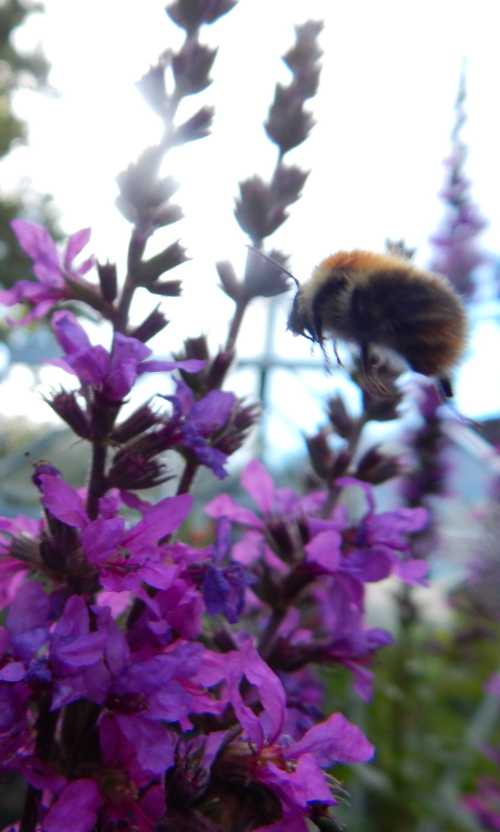
5. Modelling As A Method Of Calculating The Distance A Bee Can Fly
Using data concerning the energetic costs of bumble bee flight, researchers such as Heinrich and Cresswell have analysed information such as flight data and nectar consumption, rewards per flower, time taken to gather nectar and so on, in order to calculate the limit of distance a bee would be able to fly to gather food.
The limits of these models is the focus on nectar, whereas pollen collection is less understood.
References
1. Beekman, M, Ratnieks, F. L. W. (2000) Long-range foraging by the honey bee, Apis mellifera L. Functional Ecology Volume 14, Issue 4.
2. Frisch, Von K. (1967) The Dance Language and Orientation of Bees. Harvard University Press, Cambridge, MA.
3. Ben Darvill, Mairi E. Knight and Dave Goulson 2004 Use of genetic markers to quantify bumblebee foraging range and nest density. OIKOS 107: 471 478.
4. Roubik DW, Aluja M. 1983. Flight ranges of Melipona and Trigona in tropical forests. J. Kans. Entomol. Soc. 56: 217–22.
5. Long distance foraging and recruitment by a stingless bee, Melipona mandacaia, Brunno Kuhn-Neto, Felipe A.L. Contrera, Marina S. Castro and James C. Nieh Apidologie 40, 472-480 (2009).
6. Janzen DH. Euglossine bees as long-distance pollinators of tropical plants. Science. 1971 Jan 15;171(3967):203-5. doi: 10.1126/science.171.3967.203. PMID: 17751330.
7. Araújo ED, Costa M, Chaud-Netto J, Fowler HG (2004) Body size and flight distance in stingless bees (Hymenoptera: Meliponini): inference of flight range and possible ecological implications. Brazilian Journal of Biology 64(3B): 563–568. doi: 10.1590/S1519-69842004000400003
If you found this page helpful or interesting, I'd really be grateful if you would share it with others - if not this page, perhaps another, such as Gardening For Bees.
Thank you so much :) .
